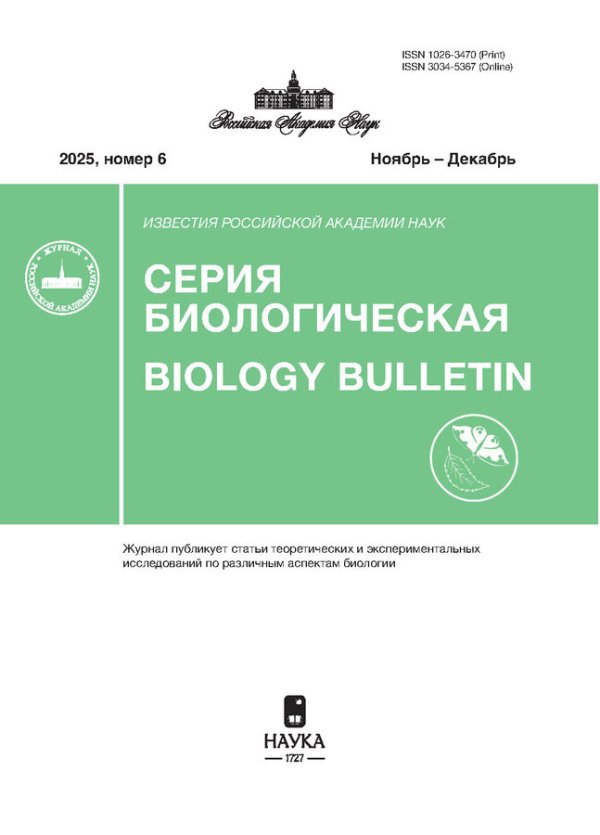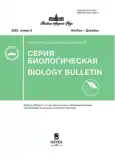No 6 (2025)
BIOCHEMISTRY
A variety of micromycete metabolites in halophytes from the White Sea coast
Abstract
 609-615
609-615


BOTANY
Variability of earlywood vessel row number of pedunculate oak (Quercus robur L.) and common ash (Fraxinus excelsior L.) in response to external factors
Abstract
 616-629
616-629


ZOOLOGY
Natural and experimental hybridization using the house mouse as an example
Abstract
The data on hybridization of house mice in nature and experiments accumulated over the last decades are summarized and analyzed. When analyzing hybridization of house mice in natural conditions, the emphasis is placed on discussing the accumulated information on the European hybrid zone between Mus musculus musculus and M. m. domesticus and its use in studying postzygotic reproductive barriers between fertile parental forms. In experimental conditions, hybridization of house mice is considered in the review more broadly, but mainly with the involvement of the same inbred lines of Mus musculus s. str. extracted from nature or bred from them. The problems of reduced viability, genomic incompatibility in hybrids, interspecific and intraspecific hybrid sterility (factors causing it, role in speciation) are analyzed. The analysis of the results on the molecular-cytogenetic mechanisms of hybrid sterility caused by various meiotic anomalies associated with impaired fertility, as well as on the gene control of the phenomenon observed during hybridization of house mice, was carried out.
 630-643
630-643


ФИЗИОЛОГИЯ ЖИВОТНЫХ И ЧЕЛОВЕКА
Effect of PANNEXIN 1 knockout on contraction of mouse mesenteric arteries in obstructive cholestasis
Abstract
 644-653
644-653


ECOLOGY
Determination of phytoplankton carbon by the content of suspended organic matter and chlorophyll a in water
Abstract
 654-663
654-663


Relative influence of the temperature and rainfall on the interannual dynamics of chlorophyll in small shallow temperate lake
Abstract
 664–680
664–680


Russian peat bogs afforestation dynamics assessment based on satellite monitoring data
Abstract
The climate regulating potential of Russian peat bogs are considering primarily as a huge reservoir of organic carbon accumulated in various soil horizons. At the same time, due to limited economic value the sparse forests and other woody vegetation of peat bogs is poorly studied. However, forest trees and other woody vegetation growing on peatlands are occupying big area and integrally may provide a significant contribution to the absorption of carbon dioxide. The results of satellite observations indicate the processes of afforestation of open peat bogs in different regions of Russia. A systematic study of these processes for entire Russia was based on satellite monitoring data for the period of the years 2001–2024. It was estimated that the area of open peat bogs annually identified over the country varies in the range of 121.5–129.5 million hectares. At the same time, the dynamics of their area is characterized by a downward trend at about 346 000 hectares per year, and in the period of the years 2011–2024, the magnitude of this negative trend reached 622 000 hectares per year. The area of peat bogs covered with forests and sparse trees increased during this period by 5.5 million hectares, and its average annual increase was estimated at about 241 000 hectares per year.
 681-689
681-689


Gully-ravine systems as unique habitats sustaining rare species of plants, fungi, and myxomycetes
Abstract
 690–705
690–705


Biodegradation of polymers by Zophobas morio larvae (Review)
Abstract
 706-719
706-719


Destruction of polystyrene by larvae Ulomoides dermestoides (Chevrolat, 1878) (Coleoptera: Tenebrionidae)
Abstract
 720-728
720-728


Chloroplast DNA Polymorphism of Medicinal Plant Eleutherococcus senticosus (Rupr. et Maxim.) Maxim. on the South of the Russian Far East
Abstract
 729-734
729-734











